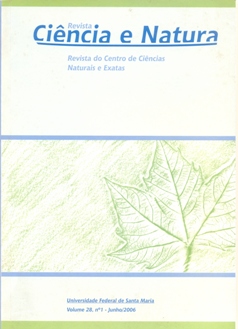Um Sistema de Informações Geográficas para Integração dos Dados de Campo e da Fotointerpretação Florestal de Imagem Digital de Alta Resolução
DOI:
https://doi.org/10.5902/2179460X9712Resumo
Implementou-se um sistema de informações geográficas a partirde dados obtidos da fotointerpretação de imagem digital de alta resolução e de dados obtidos em campo, ambos de uma área experimental dedois hectares de Floresta Ombrófila Mista localizada na Floresta Nacional(FLONA) de Irati-PR. O objetivo geral desse trabalho foi mostrar apotencialidade da integração de geo-objetos poligonais, representandoas copas das árvores resultantes da fotointerpretação florestal, com dadosflorestais diversos mensurados em campo, em um SIG orientado aobjeto. Os dados disponíveis viabilizaram a implantação de um bancode dados orientado aos dois geo-objetos "Árvore" e "Parcela". Atravésdesses, foi possível a visualização da distribuição espacial das árvores ede seus atributos, por consultas espaciais, por expressão lógica e poragrupamentos. Os dados da fotointerpretação florestal consideraramapenas as árvores cujas copas fazem parte dos estratos superiores da floresta.A integração dos dados de campo e de fotointerpretação em umSIG permite compreender melhor aspectos fisionômico-estruturais dafloresta, proporcionando análises pormenorizadas e visualização dos dadosdo experimento, necessários aos estudos florestais que se deseja executarna área investigada.Downloads
Downloads
Publicado
Como Citar
Edição
Seção
Licença
Para acessar a DECLARAÇÃO DE ORIGINALIDADE E EXCLUSIVIDADE E CESSÃO DE DIREITOS AUTORAIS clique aqui.
Diretrizes Éticas para Publicação de Revistas
A revista Ciência e Natura está empenhada em garantir a ética na publicação e na qualidade dos artigos.
A conformidade com padrões de comportamento ético é, portanto, esperada de todas as partes envolvidas: Autores, Editores e Revisores.
Em particular,
Autores: Os Autores devem apresentar uma discussão objetiva sobre a importância do trabalho de pesquisa, bem como detalhes e referências suficientes para permitir que outros reproduzam as experiências. Declarações fraudulentas ou intencionalmente incorretas constituem comportamento antiético e são inaceitáveis. Artigos de Revisão também devem ser objetivos, abrangentes e relatos precisos do estado da arte. Os Autores devem assegurar que seu trabalho é uma obra totalmente original, e se o trabalho e / ou palavras de outros têm sido utilizadas, isso tem sido devidamente reconhecido. O plágio em todas as suas formas constitui um comportamento publicitário não ético e é inaceitável. Submeter o mesmo manuscrito a mais de um jornal simultaneamente constitui um comportamento publicitário não ético e é inaceitável. Os Autores não devem submeter artigos que descrevam essencialmente a mesma pesquisa a mais de uma revista. O Autor correspondente deve garantir que haja um consenso total de todos os Co-autores na aprovação da versão final do artigo e sua submissão para publicação.
Editores: Os Editores devem avaliar manuscritos exclusivamente com base no seu mérito acadêmico. Um Editor não deve usar informações não publicadas na própria pesquisa do Editor sem o consentimento expresso por escrito do Autor. Os Editores devem tomar medidas de resposta razoável quando tiverem sido apresentadas queixas éticas relativas a um manuscrito submetido ou publicado.
Revisores: Todos os manuscritos recebidos para revisão devem ser tratados como documentos confidenciais. As informações ou ideias privilegiadas obtidas através da análise por pares devem ser mantidas confidenciais e não utilizadas para vantagens pessoais. As revisões devem ser conduzidas objetivamente e as observações devem ser formuladas claramente com argumentos de apoio, de modo que os Autores possam usá-los para melhorar o artigo. Qualquer Revisor selecionado que se sinta desqualificado para rever a pesquisa relatada em um manuscrito ou sabe que sua rápida revisão será impossível deve notificar o Editor e desculpar-se do processo de revisão. Os Revisores não devem considerar manuscritos nos quais tenham conflitos de interesse resultantes de relacionamentos ou conexões competitivas, colaborativas ou outras conexões com qualquer dos autores, empresas ou instituições conectadas aos documentos.






